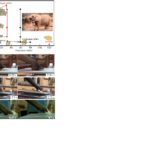Paper, Suction Feeding by Elephants
Despite having a trunk that weighs over 100 kg, elephants mainly feed on
lightweight vegetation. How do elephants manipulate such small items?
In this experimental and theoretical investigation, we filmed elephants at
Zoo Atlanta showing that they can use suction to grab food, performing a
behaviour that was previously thought to be restricted to fishes. We use
a mathematical model to show that an elephant’s nostril size and lung
capacity enables them to grab items using comparable pressures as the
human lung. Ultrasonographic imaging of the elephant sucking viscous
fluids show that the elephant’s nostrils dilate up to 30% in radius, which
increases the nasal volume by 64%. Based on the pressures applied, we estimate
that the elephants can inhale at speeds of over 150 m s−1, nearly
30 times the speed of a human sneeze. These high air speeds enable the elephant
to vacuum up piles of rutabaga cubes as well as fragile tortilla chips.
We hope these findings inspire further work in suction-based manipulation
in both animals and robots.
Learn about our two Decals!
 Click here to find out more about our Fall Bioinspired Design Decal and our Spring Bioinspired Design in Action Decal – ALL MAJORS are welcome.
Click here to find out more about our Fall Bioinspired Design Decal and our Spring Bioinspired Design in Action Decal – ALL MAJORS are welcome.Berkeley BioDesign Community
 Click here to learn about the BioD: Bio-Inspired Design @ Berkeley student organization or here to signup for more info.
Click here to learn about the BioD: Bio-Inspired Design @ Berkeley student organization or here to signup for more info.Search
Student Login





I imagine that the neurological circuits underlying these processes are governed by both 2d spacing maps with their brains as…
to reduce the impact of car accidents, it may be possible to study the force diverting physics of cockroaches to…
you see this type of head-bobbing stability in many avian creatures related to pigeons like chickens. the head ability to…
not like they taught horses how to run! this is an example of convergent evolution where both sea creatures and…
The brain functions in a similar way with neuronal connections. our brains are able to utilize the multiplicity of connections…